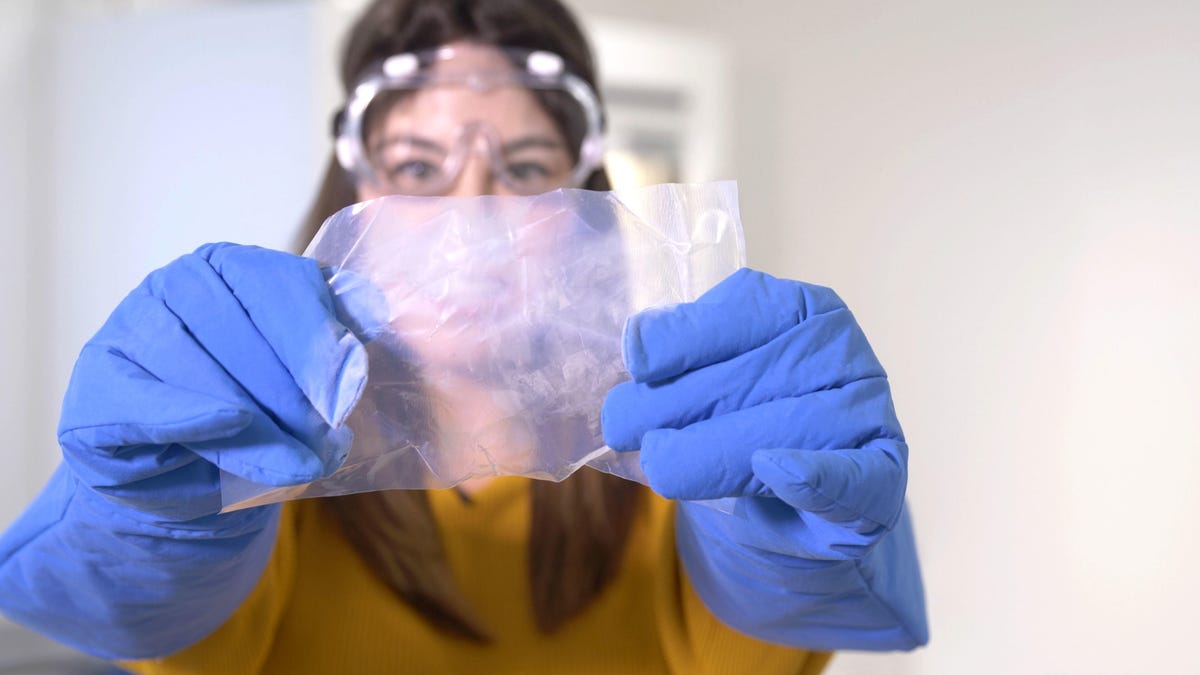The minds behind Gore-Tex are going inside your laptop and your body -- and to Mars
Thought Gore-Tex was just about waterproof jackets? Think again.

Pull-ups are tough. They're even more intimidating when the pull-up bar is suspended by a paper thin piece of plastic. Gore, the company behind Gore-Tex, has engineered a plastic that promises to hold 500 pounds without breaking. To give it a try, I nervously lift my feet off the ground and I'm hanging by what feels like a literal thread.
I'm at the Gore Innovation Center in Santa Clara, California, a collaborative space where startups can dive into Gore's catalogue of materials and fabrics. While W. L. Gore and Associates, based in Newark, Delaware, has been around since 1958, it's only in the past year the company has fully opened the door to Silicon Valley with an official presence. Gore's hoping the space will help further breakthroughs with its materials in industries from cars to consumer electronics.
Gore's core material, called expanded polytetrafluoroethylene, or ePTFE, is essentially what's found in your Gore-Tex jacket and waterproof Converse or Adidas shoes.
This is how you expand PTFE.
First created by Bob Gore back in 1969 when he quickly stretched regular PTFE, it's a versatile material. Gore discovered it's water resistant, extremely strong and has a huge thermal temperature range. You can find ePTFE in everything from laptops to 5G cabling to firefighting gear -- and even on the Mars rover.
High-performance laptops are just one everyday product taking advantage of ePTFE. When playing a resource-intensive game or crunching 4K video, laptops can get pretty hot, so developers often have to throttle performance to cool things down and avoid burning you. When blended with an insulator called Aerogel -- the same material developed by NASA to help protect spacecraft during re-entry -- ePTFE can help insulate against high temperatures.
This thin, flexible sheet can currently be found in laptops like the Dell XPS 13. It sits underneath the heat pipe, protecting heat from going up through the PC enclosure, directing it through the fans instead of the keyboard.
The small strip of Gore material that sits underneath the heat pipe.
I got to see this insulation in action. The Innovation Center's chief technical scout Michael Magyar sets up two crayons on a hotplate, but only one has the material underneath. The crayon without insulation melts into a bubbly mess within a minute and a half, while the insulated crayon remains pretty much intact.
It's not just extreme heat that ePTFE withstands. To test out extremely cold temperatures (in the order of minus 196 degrees Centigrade or minus 320 degrees Fahrenheit) Magyar leads me to a new lab at the back of the center with two long work benches, an industrial oven and plenty of Gore-Tex swatches.
He presents me with a vat of liquid nitrogen and two pieces of plastic. One is a regular freezer bag, while the other is Gore's material. It's used to store special, expensive biologic drugs, so they don't interact with the environment or degrade over time when they're stored in very cold temperatures around minus 80 degrees Centigrade/minus 112 degrees Fahrenheit. "Those drugs have to go into conditions that are more similar to the surface of Mars than anywhere here on Earth," Magyar says.
Most other materials lose their strength and can fracture when subjected to extreme cold. To test it out, I pour a ladle full of liquid nitrogen over the regular freezer bag. With a pair of cryogen gloves, I pull the bag apart and it shatters like a graham cracker. Rinse and repeat with the cryo bag, but this time I can't get it to break.
A regular freezer bag cracks under the pressure of liquid nitrogen.
PTFE is even suitable to use inside the human body, and it's currently found in stents for opening up arteries. According to Gore, this material is inert so a patient's body won't reject it. One of the other collaborative projects I played with at the center was a wearable called the Kenzen patch that helps monitor industrial workers' vitals to prevent them from overheating. About half the size of a credit card, it attaches to the skin using a Gore adhesive material that's thin, flexible and breathable.
With Gore being the brains behind Gore-Tex, it's no surprise the company is also experimenting with other thin sensors that can integrate seamlessly into items like workout leggings. I wore a prototype pair to measure strain from my knee while riding a stationary bike. Two thin sensor strips that look like sticky tape sit over the knee and feed data back via a Bluetooth box. It doesn't take much to imagine a future version might also read your vitals and help you train more effectively.
All these applications just scratch the surface of what's possible with PTFE right now. I ask Linda Elkins, co-leader at the Innovation Center, what the next big application for Gore's materials will be. "It's hard for me to say what the next great one is because we haven't discovered it yet," she says.
The video on this page is an episode of Beta Test, the show that puts you in the front seat with me as I test out crazy tech products and experiences. Check back each month for a new show! You can also find the series on YouTube.
Video correction, May 8: Storage bags are used to hold drugs in a sterile environment; Gore uses multiple methods to test the bags and not specifically liquid nitrogen as in our demo.

